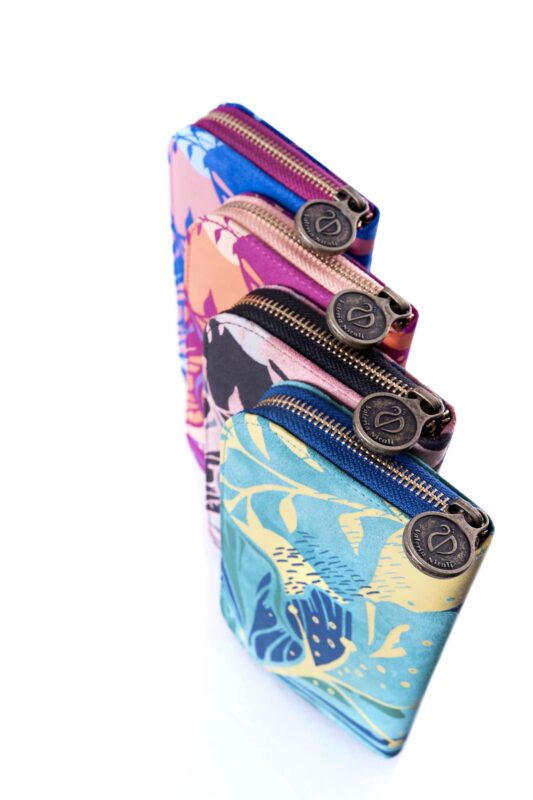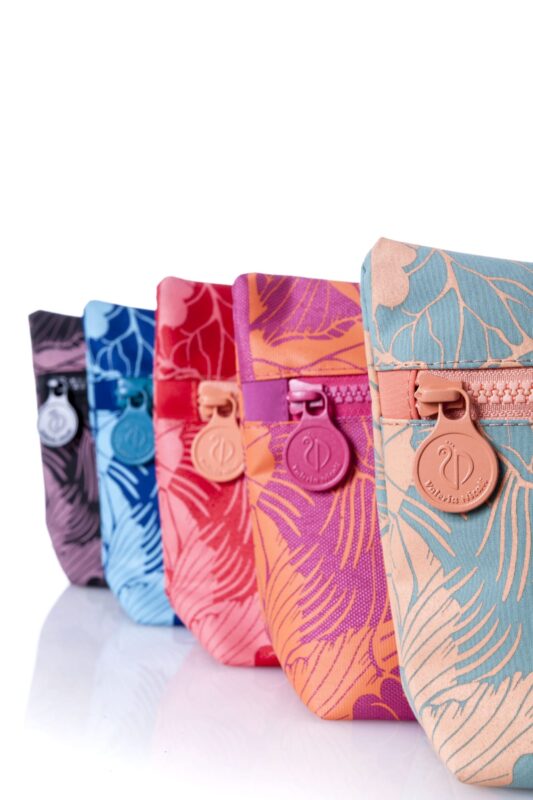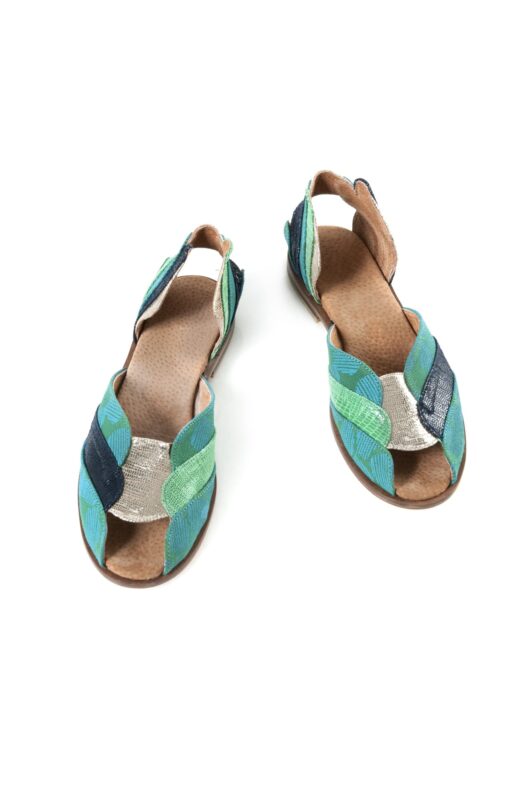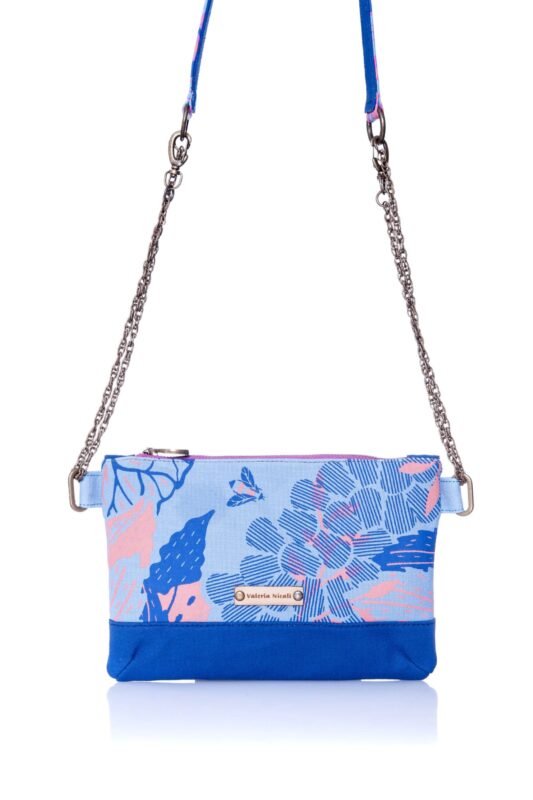It is a hot and humid summer afternoon in Buenos Aires and I arrive just in time at a small store in the Villa Crespo neighbourhood. The showcase displays handbags, shoes and other products playfully, alongside a bike and a pair of swings. Valeria Nicali is the designer behind those colourful items. She channels a personal aesthetic through her accessories and, at the same time, tells a story to the world. Over the past few years Nicali has collaborated with several native communities and turned their ancient techniques and artisanal work into fashionable pieces.
Nicali started creating bags for herself when she was a teenager, just as a hobby. “What caught my attention at first was the possibility to create these details from a personal view and way. And, as a teen I was seduced by the whole DIY idea. Then, it took its own course and here we are”. However, when the moment came, she decided to study graphic design at Buenos Aires University (UBA).
Why did you choose to focus on accessories?
I never felt enough attraction to clothes to consider doing my own garments. Accessories are a detail, a wink, an accent that you add to your outfit. Actually, I never followed fashion, in the sense of trends. I always had a personal aesthetic. Maybe both coincided sometimes, but it had always something to do with me and not with just following trends. I focus on the product, on the object as an accessory for an outfit.
Besides, women love accessories in general. They collect them, some go crazy for shoes. Accessories are considered objects of desire, something you treasure. For instance, you can keep a handbag for really a long time. On the other hand, those are pieces that define you to some extent. They show a personality, a feature or stamp. Maybe you are conservative on your clothing but you have an edge when it comes to your bag.
How did your education impact on your work as a designer?
On a radical level, basically. As I previously said, I wasn’t directly attracted by clothing at any moment. In fact, if I had to go back to study I wouldn’t choose clothing design either. The training I was given at UBA was very projective, conceptual and broad. I think that it laid the foundation to be able to think about the collections and lines while understanding something that is key: the communication in the product. It must say something. I choose an object to accessorise my look, so it must have a personal mark and transcend its use. In other words, it doesn’t have to be just a bag or a shoe, but something that tells you a story.
Enlarge
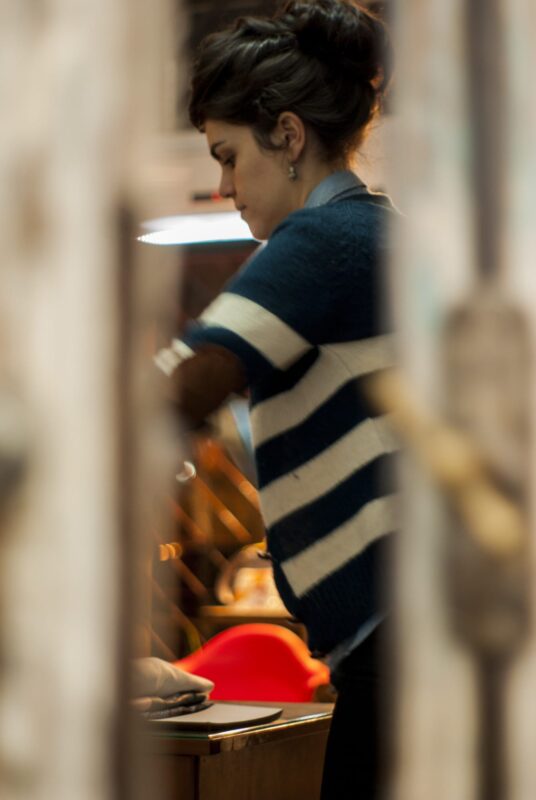
Valeria Nicali
So, what is the message behind your collections?
It changes over time. The strongest message that we have been communicating is related to the idea of going back to culture, to understand where we come from, our origins. We’ve been working with women from native communities for our past collections. We try to recover the pieces developed by them, to enhance the value of their cultural knowledge, their heritage and the resources that they put together to create the objects.
Even though the spring-summer collection doesn’t have this stamp predominantly, the brand is always looking for the possibility to revive current issues, values and traditions. We are a national label. I like talking about us as people: who we are and where we come from. Sometimes these intentions are set on a first level of reading while other times are in the background, but my perspective is always the same.
What is your creative process?
A mess! (She laughs). There is always a moment when I have to sit down and start working on the next collection. It’s like turning the page on the notebook. In general, there is always “something” of the upcoming collection that is related to what is happening at present time. We had a period of working closely with many native women from all over the country, so the possible route to travel from one community to another one would lead the way for us.
I had many experiences traveling during last year and owing to personal stuff that happened, I decided to work in a different way for the following collection: to go back to basics, as one might say. I wanted to do some introspection, to come back to our origin and work in plain terms, without asking the product to say something even though there’s a morphological search and we use prints a lot (most of our products are developed through serigraph).
Why did you take this turn?
This happens sometimes: you get a call to go back to the simplicity, to reinvent oneself. It strikes me that this is what you will see in the collection. We transmitted so much precise content and made collections overloaded with messages in the past. We worked with Guaraní, Chaqueños and Mapuche communities. (In fact, we happened to receive some of their pieces recently because we have kept in touch, a thing I love.) Collaborating with these communities started as a way of working for each season and it proved to be such a rich experience. We keep ties as a high value for us. This is something that we support as a brand, beyond each collection and maybe even works as a capsule one (something extremely fashionable nowadays).
How did the collaboration with native communities begin?
The idea of intervening the textiles, of creating your own patterns and prints wasn’t so common many years ago. These days it is something that no longer stands out. At the time, we worked on our first collections which were more playful, with smaller messages and more focused on the aesthetics. Then, we started wondering “What is the message behind our prints?” I never said something like “stars are in, let’s do that”, so I questioned what I wanted to put forth.
Our first collection was created in 2013 and was called Amerindia (Amerindian). It was our first query around the native people and communities, kind of a quick look at the topic. Time went by and I met a group of Guaraní women during an event at the National Library in Buenos Aires. I was thinking about the following collection then. We had just launched a collection called Austral, about endangered animals from Patagonia. For the subsequent season, the focus was already on the Mesopotamia region and then I met those women. Everything made sense.
So, we traveled to Misiones province, visited their workplace and what they did. This story opened a chapter for the label that went on for two years, approximately. In my view, it was really interesting and highly valuable. We keep in touch with some of the communities and sometimes we take on projects that have nothing to do with the brand, but are thought to bring them new tools and to allow them to gain visibility, which is one of their quandaries. They make remarkable things, but they are a million miles away, so it is hard for them to get acknowledged.
What do you take from them?
Above all, I have to say that their processes and mainly with the aim of transmitting them, even when we don’t actually apply them to our production. The mission of our work with these women is to be able to spread the word about what they do. Our eyes are accustomed to seeing the final result of their work, the product, but are unaware of how they work to accomplish that. For instance, how the native people reap the cane in Misiones, how they process it, how and with which material it is dyed, how it is knitted, and how many hours each step takes.
Our purpose is to be able to keep and understand the traceability of the product so that when it arrives at the showcase you are able to explain the public: “This thing that you see as an ordinary basket, was a cane as a matter of fact. That cane was peeled, dried under the sun, dyed with leaves that give a certain colour, etc.” Then, the customer’s perspective on what he sees changes radically. It gives more value to the hard work’s fruit. I like the idea of working together, being able to exhibit their work through our pieces and making them more visible to the audience.
Nowadays, there are a lot of things going on with national artisans and native communities. Each initiative has a certain positive motivation, all of them are valid. Mine is this one: that a product displayed here in Villa Crespo can tell a person that stands before it that it comes from Misiones alongside a huge story that lies behind.
Another essential reason for our collaboration is the fact that women from these communities usually take their work for granted. They don’t see the value of what they do. Their knowledge is immensely valuable but since they don’t have a way to verify it specifically, they might not give it the real importance and stop working or passing it along. For example, you would die to be able to knit like them and they diminish it, saying “Nah, this knitting is a silly thing,” so you have to show them that they are the only ones that know how to do it and to give real value to it.
It is part of our job to show them that they became a part of something that they have never dreamt of. When each community saw the final stage of the product and how it looked as a finished object, they were all astonished. And this small gesture may drive them to work and investigate more, to prevent them from losing their ancient knowledge and pass it down from generation to generation instead.
How do you balance the old traditions from the native communities with the innovation required for a fashion product?
This is a principle that I impose upon myself frequently. I try to reach undiscovered ground as much as I can (she laughs). To put it another way, I try to take the plunge and push the limits. For instance, when we worked with Chaguar (a knitted cloth made out of the homonymous plant), the native women normally create octagonal cloths with a certain patterning and way. I searched for a way out of this “comfortable zone”: So, I asked for circular cloths and worked in a different way.
I strongly believe that this is the necessary challenge. When design takes part on a project like this one, my intention is to put a new twist on it, to use a new language to redesign it and be able to get to a new public that would not consume this artisan process otherwise. Another example: if you consider basketmaking, you might think of the picnic basket. But if you try to apply it to create a crossbody bag, a backpack or a handbag, it would represent a completely different challenge and would be looked as an unusual object.
“Our eyes are accustomed to seeing the final result of their work, the product, but are unaware of how they work to accomplish that. For instance, how the native people reap the cane in Misiones, how they process it, how and with which material it is dyed, how it is knitted, and how many hours each step takes”. Valeria Nicali
What do you think is your personal stamp?
Working on design with a creative process, you are inevitably reflected on your products. You are exposed on what you do. Although you come up to a result and it represents you and the brand at that moment, I believe in renewing yourself. Change and enlist in a new search. Basically, I am talking about the feeling that the final product or the result has not run out.
The products have a certain aesthetic that remains over the seasons, such as our work with colours. I believe the brand has an identity. I suppose that the client is the one who makes the judgement of where’s our strongest stamp or feature.
Apart from that, this is a process that is happening with the brand because when we reach a certain place. We try to redefine it, to improve it and renew the label with each collection. We try to suggest something new. In conclusion, maybe dynamism is related to the stamp.
How is your next collection, Winter-Autumn 2017?
As I said, the upcoming collection is one that tries to strip pretty much of the contents. It is a bit more formal, perhaps. We have done so many collections with the main idea of communicating our message, that we decided to take a pause on this one. We set off from the gestures, the form and the colour. We worked from a more abstract viewpoint due to a need to turn to new topics and new approach.
I went on many journeys last year. We were in two international expositions: Rooms in Tokyo and White in Milan. We were also part of Micsur in Colombia in October. This was really useful to see the brand in a new perspective. As you know, you may become absorbed in what you’re doing. As a result, I found that I needed to stop and start again. I felt comfortable going back to something simpler and the brand has an identity that allows the product to speak for itself.
What does the future hold in store for Valeria Nicali, for your brand?
We have an important launch in March: we are participating in Feria Puro Diseño (a fair in Buenos Aires dedicated to creative design). It has been organised in May for many years now, but this year it is coming ahead of time. My first time at this fair was also in March, in 2009, and it was great for me. So, I hope that March would have a positive connotation again for us. All in all, it will be a quiet year when it comes to external activities; I’ll clear up my schedule a little and keep things closer to the store because I’m going to become a mother.
Tags
Accessories / Argentina / Design / Fashion / Feria Puro Diseño / Native communities / Valeria Nicali
Accessories / Argentina / Design / Fashion / Feria Puro Diseño / Native communities / Valeria Nicali

